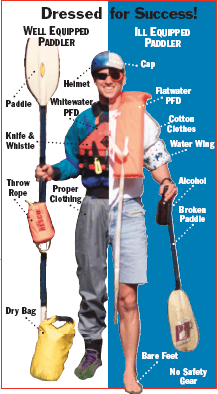Before you enjoy the thrill of a white knuckle ride down a river, make sure that you read this river rafting safety guide.
When the weather gets nice and the water in your local river gets warm enough to bear, there’s nothing quite like a day out on the river surrendering to the flow of water rushing downhill.
However, in addition to being a good time, recreating on the river can be dangerous. Although the number of deaths and injuries from river rafting is small in comparison to the number of people who go out and do it each year, there is always some inherent risk involved in this sort of activity.
Before you head out on the river this summer, you should learn or review all the pertinent safety tips related to this particular type of summer activity. You will feel much better and will have great peace of mind when you’re out there on the water.
Types of River Rafting
When it comes to river rafting, there are two main types. Both are very enjoyable and will bring out the kid in you, but they are quite different from one another.
White water Rafting

The first type of rafting is often known better as whitewater rafting. This sort of rafting usually involves two or more people in a single boat that looks a bit like a large inflatable rowboat. The people in the boat work together to paddle down a river through both calm sections and rapids of varying difficulty.
In this type of river rafting, the two main goals are to paddle hard and to keep everyone safe and in the boat as you work your way around, over, and through various river obstacles.
Often, whitewater rafting is a commercial enterprise. Customers experience the rafting trip with an experienced guide at the helm. However, in some cases, people choose to attempt whitewater rafting on their own; this is not recommended unless you are with someone who is trained not only in raft guiding but also to respond to emergencies.
Tubing
Tubing, on the other hand, is generally a lot more laid back and mellow. This type of rafting is less action-packed in most cases and is more of a relaxing float downstream.
Participants each sit in a personal tube. Sometimes groups of friends bring along beverages or other refreshments to enjoy along the way. Because tubing is usually enjoyed on a river that is rather slow-moving, tubers might even hop off their tube to swim from time to time.
This form of river rafting can be done through an outfitter or independently. Both options have their own sets of pros and cons; decisions are made based on personal preference.
River Rafting Safety
These two types of river rafting are vastly different, but there are some safety rules that apply to both of them. Make sure you are prepared for your big day out on the river.
Before Your Trip

When planning your trip, you should take into consideration your wants, needs, and abilities. You do not want to put yourself and other members of your party in danger. The most important part of having fun with your friends is staying safe.
Choose a river upon which you will feel comfortable and one with a good flow rate. If the water is too high, you could get swept away – or worse yet, under. On the other hand, if the water is too low, you will spend much of your time running into rocks and getting stuck.
When the time comes to go on your trip, check the weather conditions. If you are going rafting with an outfitter, they will let you know if the weather will result in conditions that are too dangerous, but if you are going independently, that decision will be on you. Don’t take unnecessary risks. If there will be rain or thunder and lightning, it might be better to choose a different day to go.
During Your Trip
Anytime you are in moving water, it’s wise to wear a life jacket. Most outfitters will require that you wear one, but if you are going alone, you should wear one then, too.
Because the river bottom can be rocky and slippery, you should also wear sneakers, sandals, or water shoes as well for traction. If it’s early in the season, the water may be very cold; you might consider wearing a partial wetsuit also.
If you fall out of the raft or out of your tube during a quick-moving section of water, always try to turn your body so your feet are heading downstream. That way, you can see where you are going and can avoid running into anything or getting stuck.
White water Rafting Considerations
As you might imagine, whitewater rafting is usually far more dangerous than tubing. As a result, there are additional safety precautions to consider.
First and foremost, stay in the boat. The more you paddle, the better chance you have of staying put, so paddle as much as you can during the fastest moving sections.
You should also listen to your rafting guide for directions. He or she will give you a safety talk before you get out on the river and it is important that you listen to all of it. The commands and instructions that you will learn might just save your life.
Most of all, if something unexpected happens, don’t panic. Keeping your wits when you are suddenly in the water is exactly what will help you to get back into the boat in a rapid and safe manner.

Happy Rafting
Whether whitewater rafting or tubing is more your cup of tea, you can have a great time on the water while river rafting. However, the fun will be over fast if someone gets hurt. The best way to avoid getting hurt is to know the best safety rules and procedures before you get in the water. Have fun out there and be safe this summer and beyond.
If you are interested in learning more about the high-quality, inflatable river rafts we offer, please contact us today. We look forward to speaking with you and we can’t wait to tell you about our products!
